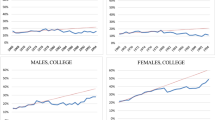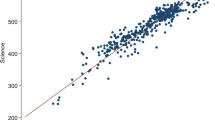Abstract
Educational attainment varies greatly across countries and within countries over time. This paper asks whether the variation in education is primarily due to industry composition or to within-industry skill intensities. The main finding is that within-industry variation accounts for at least two-thirds of the cross-country and the time-series variation in educational attainment. The within-industry education gaps are broadly consistent with a model of industry neutral cross-country differences in skilled labor productivity. These results suggest that theories of educational development should focus on skill upgrading within industries rather than structural change.
Similar content being viewed by others
References
Acemoglu D. (2002) Directed technical change. Review of Economic Studies 69: 781–810
Acemoglu D. (2003) Patterns of skill premia. Review of Economic Studies 70: 199–230
Autor D. H., Katz L. F., Krueger A. B. (1998) Computing inequality: Have computers changed the labor market?. The Quarterly Journal of Economics 113(4): 1169–1213
Banerjee A., Duflo E. (2005) Growth theory through the lens of development. In: Aghion P., Durlauf S. N. (eds) Handbook of economic growth. Elsevier, Amsterdam, pp 473–554
Barro R. J., Lee J.-W. (2001) International data on educational attainment: Updates and implications. Oxford Economic Papers 53(3): 541–563
Berman E., Bound J., Griliches Z. (1994) Changes in the demand for skilled labor within U.S. manufacturing: Evidence from the annual survey of manufacturers. The Quarterly Journal of Economics 109(2): 367–397
Berman E., Bound J., Machin S. (1998) Implications of skill-biased technological change: International evidence. The Quarterly Journal of Economics 113(4): 1245–1279
Berman E., Machin S. (2000a) Skill-biased technology transfer around the world. Oxford Review of Economic Policy 16(3): 12–22
Berman E., Machin S. (2000) Skill-biased technology transfer: Evidence of factor biased technological change in developing countries. Boston University, Mimeo
Bils M., Klenow P. J. (2000) Does schooling cause growth?. The American Economic Review 90(5): 1160–1183
Caselli F., Coleman W. J. (2001) The U.S. structural transformation and regional convergence: A reinterpretation. The Journal of Political Economy 109(3): 584–616
Caselli F., Coleman W. J. (2006) The world technology frontier. American Economic Review 96(3): 499–522
Cordoba J.C., Ripoll M. (2009) Schooling and development: The role of credit limits, public education, fertility and mortality. Iowa State University, Mimeo
Desjonqueres T., Machin S., van Reenen J. (1999) Another nail in the coffin? Or can the trade based explanation of changing skill structures be resurrected?. The Scandinavian Journal of Economics 101(4): 533–554
Doms M., Lewis E. (2006) Labor supply and computer adoption. Mimeo, Federal Reserve Bank of San Francisco
Erosa A., Koreshkova T., Restuccia D. (2007) How important is human capital? A quantitative theory of world income distribution. University of Toronto, Mimeo
Galor O. (2000) Ability biased technological transition, wage inequality, and economic growth. Quarterly Journal of Economics 115: 469–498
Galor O. (2005) From stagnation to growth: Unified growth theory. In: Aghion P., Durlauf S. N. (eds) Handbook of economic growth. Elsevier, Amsterdam, pp 171–293
Galor O., Weil D. N. (2000) Population, technology, and growth: From Malthusian stagnation to the demographic transition and beyond. The American Economic Review 90(4): 806–828
Goldin C. (1998) America’s graduation from high school: The evolution and spread of secondary schooling in the twentieth century. The Journal of Economic History 58(2): 345–374
Goldin C. (2001) The human-capital century and American leadership: Virtues of the past. The Journal of Economic History 61(2): 263–292
Goldin C., Katz L. F. (2008) The race between education and technology. Harvard University Press, Cambridge, MA
Gollin D., Parente S., Rogerson R. (2002) The role of agriculture in development. The American Economic Review 92(2): 160–164
Gollin D., Parente S. L., Rogerson R. (2007) The food problem and the evolution of international income levels. Journal of Monetary Economics 54: 1230–1255
Hall R. E., Jones C. I. (1999) Why do some countries produce so much more output per worker than others?. Quarterly Journal of Economics 114: 83–116
Hall, P. K., McCaa, R., Thorvaldsen, G. (eds) (2000) Handbook of international historical microdata for population research. The Minnesota Population Center, Minneapolis, MN
Hansen G. D., Prescott E. C. (2002) Malthus to Solow. American Economic Review 92(4): 1205–1217
Harris J. R., Todaro M. P. (1970) Migration, unemployment and development: A two-sector analysis. The American Economic Review 60(1): 126–142
Hendricks L. (2002) How important is human capital for development? Evidence from immigrant earnings. The American Economic Review 92(1): 198–219
Hendricks L. (2008) Why does education differ across countries?. Iowa State University, Mimeo
Hendricks L. (2010) Validation of IPUMS international industry and education data. University of North Carolina, Mimeo
Hendricks, L. (2011). The skill composition of U.S. cities. International Economic Review (forthcoming).
Kaboski J.P. (2006) Endogenous Mincerian returns: Explaining cross-country variation in the returns to schooling. Ohio State University, Mimeo
Klenow P. J., Rodriguez-Clare A. (1997) The neoclassical revival in growth economics: Has it gone too far?. NBER Macroeconomics Annual 12: 73–103
Lewis W. A. (1954) Economic development with unlimited supplies of labor. Manchester School of Economics and Social Studies 22: 139–151
Lucas R. E. (2004) Life earnings and rural-urban migration. Journal of Political Economy 112(1, part 2): S29–S59
Machin S., Van Reenen J. (1998) Technology and changes in skill structure: Evidence from seven OECD countries. The Quarterly Journal of Economics 113(4): 1215–1244
Manuelli R., Seshadri A. (2007) Human capital and the wealth of nations. University of Wisconsin, Mimeo
Minnesota Population Center. (2009). Integrated public use microdata series—international: Version 5.0. Machine-readable database.
Restuccia D., Vandenbroucke G. (2008) The evolution of education: A macroeconomic analysis. University of Toronto, Mimeo
Restuccia D., Yang D. T., Zhu X. (2007) Agriculture and aggregate productivity: A quantitative cross-country analysis. Journal of Monetary Economics 55(2): 234–250
Ruggles S., King M. L., Levison D., McCaa R., Sobek M. (2003) IPUMS-international. Historical Methods 36(2): 60–65
Schoellman T. (2006) The causes and consequences of cross-country differences in school attainment. Clemson University, Mimeo
Trefler D. (1993) International factor price differences: Leontief was right!. Journal of Political Economy 101(6): 961–987
Author information
Authors and Affiliations
Corresponding author
Rights and permissions
About this article
Cite this article
Hendricks, L. Cross-country variation in educational attainment: structural change or within-industry skill upgrading?. J Econ Growth 15, 205–233 (2010). https://doi.org/10.1007/s10887-010-9055-9
Published:
Issue Date:
DOI: https://doi.org/10.1007/s10887-010-9055-9




